Finding myself in Provence for a couple of weeks I could not wait to get onto some limestone and burn off some of the inevitable extra calories accumulated by les aperos, entrees, plat prancipaux and desserts. My daughter Laura was keen to give sport climbing a try so I consulted the internet and discovered Paradou (paradise) at
http://nicobrasfort.starnux.net/wp-content/uploads/2011/01/Topo-Escalade-Paradou-2004.pdf
 |
| View from the top at Paradou |
 |
| Lots of 3's and 4's on this section (north facing so in the shade) |
After warming up on some 3's I mistakenly lead a 4+ ( I thought I was on a 3) After installing a lower off I suggested Laura have a go and not to worry if she fell off. As it happened Laura breezed up it, so we tried a few more similiar routes. By this time it was 11.00 am and time to vacate: Provencal crags in August have limited access due to fire risk. To find out if a crag is available go to http://www.bouches-du-rhone.gouv.fr/files/massif/
Invigorated by our visit to Paradou we decided to visit Chateau Virant, this time for an evening climb on its east face (shady after 6.00pm) We would take Michel our gite owner with us. I had visited Chateau Virant with Michel last year (see previous Blog) Here the climbs are a little higher that those at Paradou and as the crag is on an escarpment the view more sensational.
 | |||
| Chateau Virant (east face) |
The prospect of the crag as you approach from the car park is not very impressive: shaped like a molar tooth it has been scarred by a carved staircase to give access to a vandalised viewing platform. However the east face of the crag makes a greater impact and the staircase can prove useful if difficulties in setting lowers are encountered. The stone has a lovely white marble like appearance but still provides plenty of friction.
Someone had kindly marked the base of each climb with its technical grade from 3 to 6, thought of as an almost sacrilegious act on British rock. Out here in Provence however there is so much rock that I cannot see how a little graffiti does any harm. I must say I found the marks useful as the guide book to this area is very expensive and I do not have one!
 | ||
| Olive groves and vinyards make a great backdrop to the Chateau Virant outcrop (east face) |
As usual we warmed up on some grade 3's. The climbing was straightforward but a leader can be faced with some awkward lower off setups (paired staples in inconvenient positions with no linking chain) so plenty of slings may be needed. We soon settled into a rhythm with myself leading, belayed by Laura, then Laura removing quick draws as she climbed belayed by Michel, and lastly Michel climbing belayed by myself from the bottom of the crag.
After moving on to one or two grade 4 climbs (thanks Stephen for the extra gear) the sun dipped below the western horizon. A damp breeze blew in from the Etang de Berre giving the rock a clammy feel. We spent some time gazing up at some lovely looking grade fours but sadly our climbing session had come to an end. Maybe we'll be back next year to try them?
 |
| Michel on a Grade 4 |
Michel and his wife Bernadette had kindly invited us that evening to dinner at their gite. Several bottles of Bordeaux red were drunk making for a perfect end to great day.





























